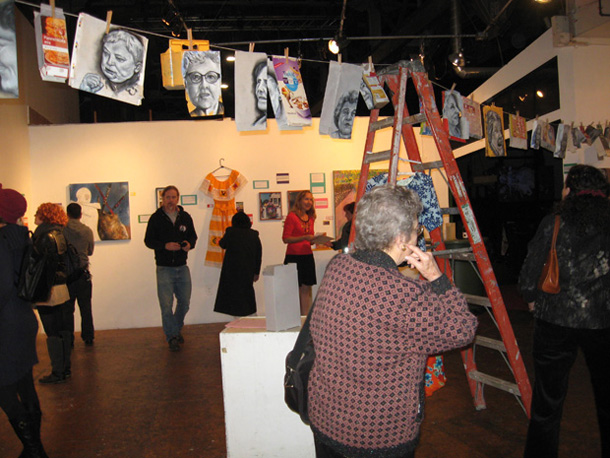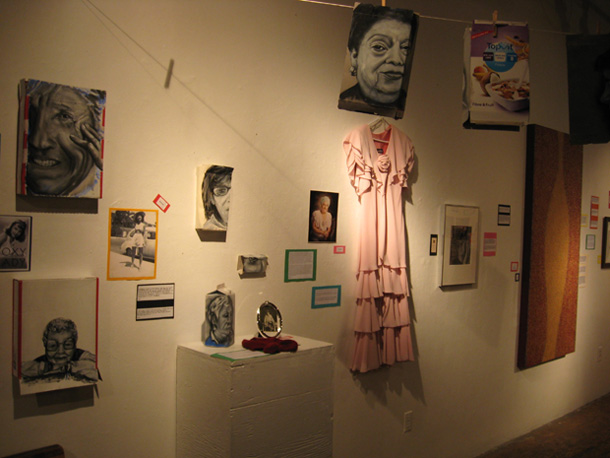Here is a guest post by social artist and teacher Julia Rice, whose work focuses on issues of beauty, advertising, and how mass media messages affect the way we see ourselves. What follows is an enlightening account of her latest art project – on women, beauty and aging.
“I’ve worked hard for these wrinkles,” an older friend of mine smiled recently over salmon quesadillas. I was explaining to her why I was here, thousands of miles from home in San Francisco, doing an art project on women, beauty and aging. This project was a strange mutt of art and sociology. I interviewed women 60 and older, recording their recollections of how they viewed beauty in their 20s, their current ideas and how things changed over the years.
During the interviews, I took photographs of their faces, which I later translated into oil paintings on disposable surfaces. In the final San Francisco exhibitions, I strung the painted boxes with clothespins on clotheslines. Colorful printed text selections from every interview hung on the walls. I also asked each woman to lend me something that represented beauty to her. I received dresses and old photographs, knitted scarves, paintings, poetry and a purply pink woven hat. One of my interviewees – a former Chicago actress – performed a 10 minute debut selection of her new play on Colette. There were flowers and wine and chocolate frosted cupcakes, donated in honor of a friend’s 85 year old mother. A talented musician friend played her hang, a kind of drum from Switzerland. I hoped both shows to be a celebration of and for the women.
This project comes after a long personal diatribe against the beauty industry, modeling, the selling of the sexualized female body. I’ve worked with these themes for years. This project also joins the current (or recent) ranks of celebrating women of all ages…the voluptuous senior models of The Calendar Club, Dove’s Campaign for Real Beauty, the recent commercial from Kaiser Permanente, “When I grow up, I want to be an old woman.”
So my celebrations are not alone, nor are my queries. I’ve spent a lot of time with contemporary consumer culture. I know “the look” of what sells – the young, long-legged beauty. And I was curious. The last 100 years have seen the birth and exorbitant growth spurt of the modern advertising industry. Almost every woman alive today in Western culture has been surrounded to some degree by advertising and subsequently, beauty images. I wondered on a deeper level how this has shaped us…how women of different generations are affected similarly or quite differently.
When I started the project, my sister asked me if older women might be hesitant to talk about “their changing image.” I didn’t find this at all. What I found were many new friends with stories about life and quite varied ideas on beauty. I also found that 60 is quite different from 90. Some women in their 60s were more troubled with physical changes than those in their 80s. One 90 year old told me that “An older woman needs to dress up because she no longer has the beauty of youth…I see women who say, “Why should I dress up since I am already old?” That is a mistake.” Everyday she arrives to her volunteer work at the Senior Center wearing lipstick, earrings and a tailored skirt. Another new friend of 83 bragged proudly of having boyfriends since she was 12 years old (as well as surviving 3 husbands).
I interviewed women who painted and taught dance and drove convertibles to the beach. Some women feared aging only because it meant losing mobility or being pigeon-holed as an “old” woman who “painted kittens on black velvet.” Women worked hard with different combinations of diet, exercise and conscientious make-up to carry themselves well and maintain good health. Some spoke proudly of where they were now: perhaps of wrinkles, yes, but also of developing passions and inner life, of swimming, traveling and having an “agreeable outlook on life.”
I spent hours listening to stories, sharing Chinese lunch or banana bread for breakfast, learning to drink cognac, looking at old pictures, laughing, smelling Winnie’s favorite gardenia perfume bought on her last trip to Hawaii. If anything, this project made me inspired to grow older well. I found no no black-and-white answers on the secrets of “beauty and aging”. I found instead new friends who shared all kinds of rich beauty with me…art, theater, books and lunch invitations, dance, laughter, stories, and by default, snippets of beauty talk: facial exercises or a daily swim in the present, slathering one’s self with Crisco or Vaseline – 60 years past – for a day at the beach.
The most significant interviews? This is a hard question to answer because if I choose two or three “favorites,” I exclude so many others. Many of the women interviewed have become friends; none remain anonymous subjects. When I think of interviews that affected me the most deeply though, Winnie’s experience of Pearl Harbor comes to mind. Jana’s early struggles with her sexuality and the poignancy of her current artwork brought me to near tears. I loved catching Emma’s vivacity, interviewing “authentic” Filipino twin beauty queens, and hearing the torrid after-interview stories of Sarah’s days in theater life (which I still think should be made into a book). Annie’s tangled family history and present journey make me wish I had more time to listen. Gwen gently helped me get started and iron out the wrinkles of how this interview business all works.
And even from afar, I received a wonderful slew of online interviews. I still get excited to think of the Dutch interviews received from my friend Leuny. She interviewed her mother and two aunts – all in their 80s – and translated their stories of growing up in post-war Netherlands from Dutch to English. I have stories from my own family, friends who interviewed their mothers and from new and old friends around the world. The blog now has over 60 such stories and interviews. I hope to continue this project. For me, more than a surface focus on the physical, it has become an exploration into the depths of human beauty and story.
– Julia Rice
February 21, 2011
Links:
[arrow_list] [/arrow_list]

Join the discussion One Comment